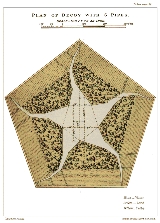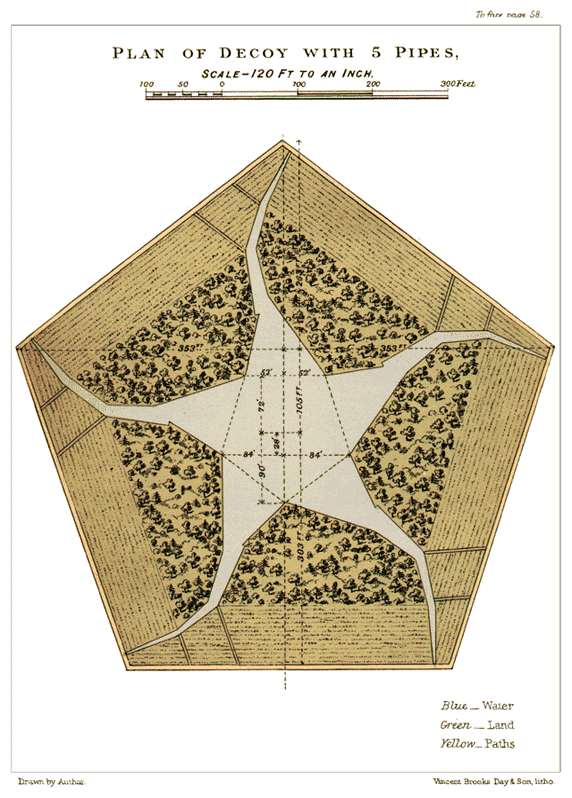
Duck decoy
Encyclopedia

Anatidae
Anatidae is the biological family of birds that includes ducks, geese and swans. The family has a cosmopolitan distribution, occurring on all the world's continents except Antarctica and on most of the world's islands and island groups...
. In former times the birds were slaughtered and used for food. Today, if the device is used, the birds are ringed
Bird ringing
Bird ringing or bird banding is a technique used in the study of wild birds, by attaching a small, individually numbered, metal or plastic tag to their legs or wings, so that various aspects of the bird's life can be studied by the ability to re-find the same individual later...
and released.
Etymology
The word decoy is derived from the DutchDutch language
Dutch is a West Germanic language and the native language of the majority of the population of the Netherlands, Belgium, and Suriname, the three member states of the Dutch Language Union. Most speakers live in the European Union, where it is a first language for about 23 million and a second...
word eende-kooi, which could mean "duck-cage",; Chambers Dictionary
Chambers Dictionary
The Chambers Dictionary was first published by W. and R. Chambers as Chambers's English Dictionary in 1872. It was an expanded version of Chambers's Etymological Dictionary of 1867, compiled by James Donald...
suggests Dutch de kooi = "the cage". These conjectures are debatable. In the case of a derivation from Dutch de kooi, the final stressing of de kooi [də'ko:j] is inconsistent with English decoy ['di:ko:j], which has initial stress. The connection with Dutch eende-kooi is also phonologically problematic, e.g. eende-kooi has initial stress ['e:ndəkoj], which might have resulted in an English form **eancoy (vel sim.), rather than decoy, with an assumed disappearance of the initial syllable.
Description
As finally developed the decoy consisted of a pool of water leading from which are from one to eight curving, tapering ditches. Over each ditch is series of hoops, initially made from wood, later from iron, which diminish in size as the ditch tapers. The hoops are covered in netting. The combination of ditch and net-covered hoop is known as a pipe. On the outside curve of the pipe, for two-thirds of its length, are overlapping screens.Operation
There are two methods of working a duck decoy, dogging or feeding.
Dogging
Ducks are naturally curious and when they see a predator, such as a fox, they will keep it at a distance, but tend to follow it. The decoyman uses a dog, preferably a breed similar in appearance to a fox, to lure the ducks along the pipes. The dog appears between a gap in the screens and the ducks approach. It then appears at the next gap further along the pipe, and so on until the ducks are trapped at the end of the pipe.Feeding
The decoyman walks behind the screens, throwing grain or other food over them while keeping out of sight. The ducks follow, eating the food, and are caught at the end of the pipe.Today
In the mid-1880s there were 41 decoys still in operation in England, and 145 which were no longer in use. Today there are only a few remaining duck decoys in England. These include Hale Duck DecoyHale Duck Decoy
Hale Duck Decoy is a duck decoy located near to the village of Hale, in Halton, Cheshire, England. It is a Scheduled Ancient Monument, owned by Hale Estates and administered by Halton Borough Council.-History:...
in Cheshire
Cheshire
Cheshire is a ceremonial county in North West England. Cheshire's county town is the city of Chester, although its largest town is Warrington. Other major towns include Widnes, Congleton, Crewe, Ellesmere Port, Runcorn, Macclesfield, Winsford, Northwich, and Wilmslow...
, administered by Halton Borough Council
Halton (borough)
Halton is a local government district in North West England, with borough status and administered by a unitary authority. It was created in 1974 as a district of Cheshire, and became a unitary authority area on 1 April 1998. It consists of the towns of Widnes and Runcorn and the civil parishes of...
, Boarstall Duck Decoy
Boarstall Duck Decoy
The Boarstall Duck Decoy is a 17th-century duck decoy located in Boarstall, Buckinghamshire, England, and now a National Trust property.At one time a common sight in the English countryside, only four duck decoys now remain. The Boarstall Duck Decoy is still in working order, and is surrounded by ...
near Aylesbury
Aylesbury
Aylesbury is the county town of Buckinghamshire in South East England. However the town also falls into a geographical region known as the South Midlands an area that ecompasses the north of the South East, and the southern extremities of the East Midlands...
in Buckinghamshire
Buckinghamshire
Buckinghamshire is a ceremonial and non-metropolitan home county in South East England. The county town is Aylesbury, the largest town in the ceremonial county is Milton Keynes and largest town in the non-metropolitan county is High Wycombe....
, owned and administered by the National Trust
National Trust for Places of Historic Interest or Natural Beauty
The National Trust for Places of Historic Interest or Natural Beauty, usually known as the National Trust, is a conservation organisation in England, Wales and Northern Ireland...
, and a decoy in Abbotsbury Swannery
Abbotsbury Swannery
Abbotsbury Swannery is the only managed colony of nesting mute swans in the world. It is situated near the village of Abbotsbury in Dorset, England, west of Weymouth on a site around the Fleet lagoon protected from the weather of Lyme Bay by Chesil Beach. The colony can number over 600 swans with...
, Dorset
Dorset
Dorset , is a county in South West England on the English Channel coast. The county town is Dorchester which is situated in the south. The Hampshire towns of Bournemouth and Christchurch joined the county with the reorganisation of local government in 1974...
.
Some are used to trap ducks for non-harmful study, such as ringing them.
Evidence of former duck decoys can be found. At Swanpool near Lincoln
Lincoln, Lincolnshire
Lincoln is a cathedral city and county town of Lincolnshire, England.The non-metropolitan district of Lincoln has a population of 85,595; the 2001 census gave the entire area of Lincoln a population of 120,779....
, cropmark
Cropmark
Cropmarks or Crop marks are a means through which sub-surface archaeological, natural and recent features may be visible from the air or a vantage point on higher ground or a temporary platform...
s revealed in aerial photographs show the outlines of a decoy. In Somerset, west of Nyland Hill there is evidence of a pond with three pipes, and in Westbury
Westbury-sub-Mendip
Westbury-sub-Mendip is a village in Somerset, England, with a population of about 800, situated on the southern slopes of the Mendip Hills from Wells and Cheddar.The parish boundary is formed by the River Axe-History:...
there is a decoy with possibly six pipes.

